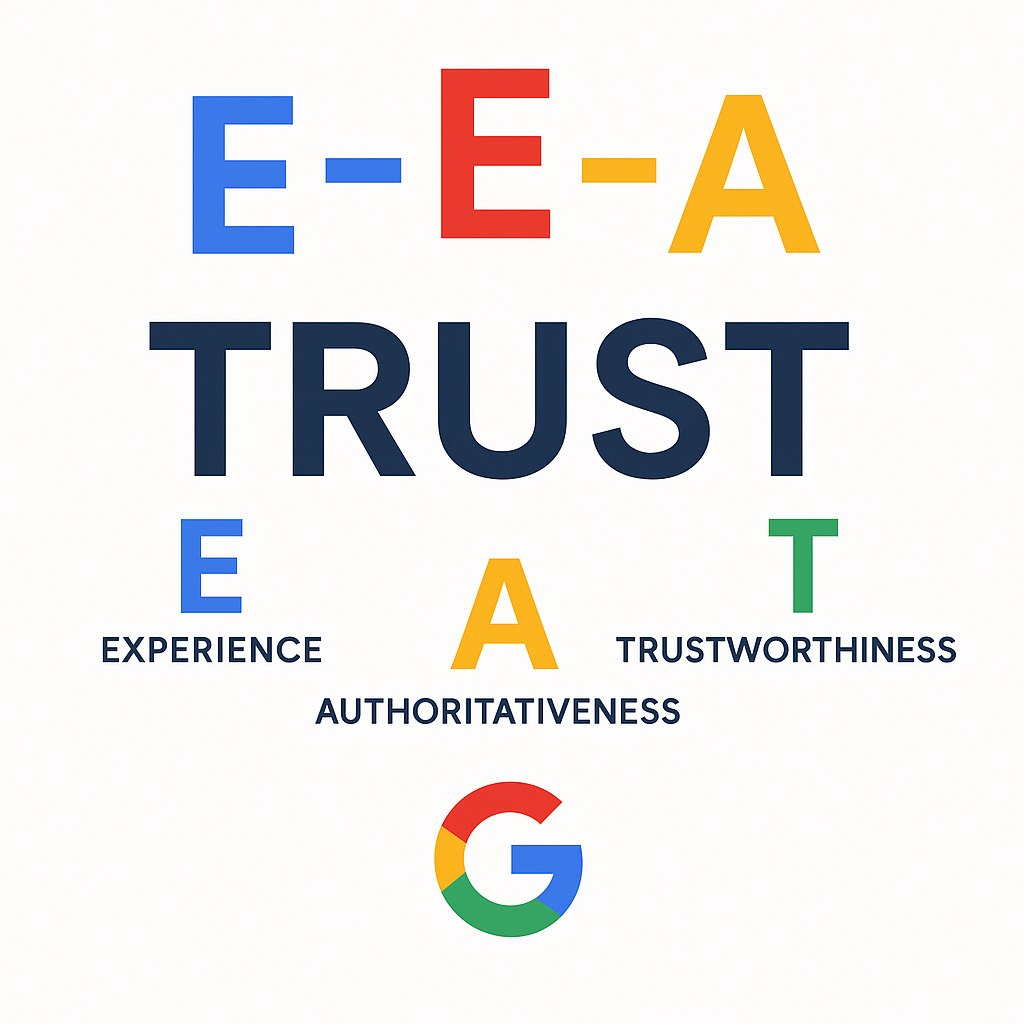When Google decides which websites deserve to rank higher, it looks far beyond keywords and backlinks. The search engine giant wants to know: Can your content be trusted? That’s where Google E-E-A-T comes in — an acronym for Experience, Expertise, Authoritativeness, and Trustworthiness.
E-E-A-T is not a direct ranking factor but a core quality framework within Google’s algorithm and Search Quality Rater Guidelines. It defines what makes web content helpful, reliable, and credible. Websites that demonstrate strong E-E-A-T consistently outperform those that don’t — especially in industries where trust matters most, such as health, finance, and business.
What Is Google E-E-A-T?
Google E-E-A-T represents how Google evaluates the credibility of a website, its authors, and the content they publish. It stands for:
- E – Experience: Does the creator have first-hand experience with the topic?
- E – Expertise: Does the author demonstrate in-depth knowledge or skill in the subject area?
- A – Authoritativeness: Is the creator or website recognized as a leading voice in the field?
- T – Trustworthiness: Is the content accurate, honest, and transparent?
Originally introduced as E-A-T in 2014, Google added an extra “E” for Experience in December 2022, recognizing that personal, hands-on insights often make content more trustworthy.

For example:
- A travel blogger who personally visited a destination provides higher “Experience” than someone summarizing online reviews.
- A doctor writing about a health condition demonstrates both Expertise and Trustworthiness.
When all four pillars align, Google considers the content high quality and more deserving of top search results.
The Four Pillars of Google E-E-A-T
Google’s E-E-A-T framework—Experience, Expertise, Authoritativeness, and Trustworthiness—isn’t just a checklist; it’s the foundation of credible content creation. These four pillars define how Google judges a website’s reliability and how readers perceive your brand’s integrity. Each element complements the others: Experience adds authenticity, Expertise demonstrates mastery, Authoritativeness builds reputation, and Trustworthiness ties everything together through transparency and honesty. Understanding these pillars allows marketers, bloggers, and business owners to structure their digital content around credibility, ensuring both human readers and search engines recognize genuine value. Let’s explore each E-E-A-T pillar in detail and how you can implement them effectively on your site.
1. Experience
Experience is the newest addition to the E-E-A-T framework, introduced by Google in 2022. It focuses on first-hand knowledge—the proof that the creator has actually done, tested, or lived what they’re writing about. Google rewards content backed by real-world involvement rather than second-hand summaries.
To demonstrate Experience, use authentic examples, original photos, or videos that show you interacting with products, services, or environments. For instance, if you review a digital marketing tool, include screenshots from your own dashboard or campaign results. Add personal narratives like “When I implemented this strategy…” to make content relatable and verifiable. Case studies, experiments, and field reports also showcase lived experience. This human layer not only satisfies Google’s evaluators but builds audience trust—because readers prefer insights from someone who’s actually been there.
2. Expertise
Expertise represents your depth of understanding and command of the topic. It shows that you possess legitimate knowledge, professional qualifications, or years of practice. Google’s algorithms and human raters look for cues that prove you’re not merely curating information—you truly understand the subject.
You can establish Expertise by adding detailed author bios highlighting credentials, certifications, or awards. Support your arguments with verified data, research, and case studies. Explain complex concepts clearly, linking to reputable sources and industry reports. Use terminology that professionals recognize without overwhelming general readers. Sharing advanced insights—like marketing metrics, real campaign outcomes, or performance graphs—demonstrates mastery beyond surface-level advice. Remember, genuine Expertise convinces readers and algorithms alike that your content is the product of real skill and not AI-generated filler or recycled commentary.
3. Authoritativeness
Authoritativeness is about recognition and influence. It’s not just what you say—it’s who acknowledges you as a credible source. When other experts, institutions, or reputable websites cite or reference your content, Google interprets that as a sign of authority. The more respected your peers consider you, the stronger your Authoritativeness becomes.

To build this pillar, focus on earning backlinks from high-authority websites, getting featured in media publications, and collaborating with thought leaders. Encourage journalists or bloggers to reference your insights in relevant stories. Maintain a consistent presence on professional platforms like LinkedIn, YouTube, or Google News. Showcase testimonials, awards, or guest appearances on your website’s “About” page. A positive brand reputation—reflected through reviews, citations, and external mentions—signals to Google that your content is dependable. Over time, these recognition layers solidify your brand as a trusted industry authority.
4. Trustworthiness
Trustworthiness is the foundation upon which the other three pillars rest. Without trust, even the most experienced or authoritative site fails to sustain credibility. Google prioritizes content that is safe, accurate, and transparent—especially for YMYL (Your Money or Your Life) topics that influence people’s health, finances, or wellbeing.
To enhance Trustworthiness, ensure your website uses HTTPS security, clear navigation, and visible contact information. Include author names, update timestamps, and privacy disclosures. Cite credible data sources to back every claim, and avoid exaggerated promises or clickbait headlines. If content is sponsored, disclose it openly. Encourage honest user reviews and moderate them fairly to prevent misinformation. Fact-checking and timely updates show accountability. In short, trust signals that your brand values truth and user safety—qualities that both audiences and algorithms reward with lasting loyalty and stronger rankings.
Google E-E-A-T Guidelines: What Google Recommends
Google’s Search Quality Rater Guidelines (QRG) are detailed instructions given to real evaluators who manually assess website quality. While these ratings don’t directly determine rankings, they help Google’s algorithm learn what good content looks like.
The Key E-E-A-T Principles
| Principle | Description | What You Should Do |
|---|---|---|
| Experience | First-hand involvement with the subject | Add personal examples, case studies, or product tests |
| Expertise | Deep understanding or credentials | Display bios, cite qualifications, use factual evidence |
| Authoritativeness | Recognized reputation | Earn high-quality backlinks and positive mentions |
| Trustworthiness | Accuracy, honesty, safety | Include disclaimers, sources, and contact transparency |
Google’s content guidelines emphasize “helpful, reliable, people-first content.” Avoid producing content just to manipulate rankings. Instead, focus on usefulness, originality, and clarity.
You can review Google’s official guidelines here: Google Search Quality Rater Guidelines.
The Benefits of Following E-E-A-T
- Higher Search Rankings: Search engines naturally reward trustworthy sites.
- More Backlinks and Mentions: Quality attracts quality; high-authority sites link to reliable sources.
- Better Conversion Rates: Users are more likely to buy, subscribe, or share when they trust your brand.
- Reduced Bounce Rate: Accurate, engaging, and expert content keeps users on your page.
- Improved Online Reputation: Positive mentions across platforms enhance your brand’s credibility.
In short, implementing E-E-A-T isn’t just about SEO — it’s about building a brand that stands the test of time.
The History of Google E-E-A-T
To understand why E-E-A-T matters so much today, let’s look at how it evolved.
2013–2014: Birth of E-A-T
Google first introduced the concept of E-A-T (Expertise, Authoritativeness, Trustworthiness) in its Search Quality Rater Guidelines (QRG) around 2014. The goal was to guide human raters in judging the credibility of web pages.
2018: The “Medic” Update
In August 2018, Google launched a core algorithm update — widely called the “Medic Update.” It heavily impacted medical, financial, and YMYL websites, highlighting how crucial E-A-T had become for rankings.
Many low-trust websites saw massive drops, while verified expert sources (like WebMD or Mayo Clinic) climbed higher.
2022: Experience Joins the Framework
In December 2022, Google expanded E-A-T to E-E-A-T, adding the new “E” for Experience. The update acknowledged that firsthand involvement adds another layer of credibility beyond academic expertise.
This change pushed creators to show proof of experience — such as product testing, personal insights, or case studies.
2023–2025: Deep Integration with Search Algorithms
Since 2023, Google’s AI-driven algorithms increasingly rely on E-E-A-T signals to evaluate quality, especially amid the rise of AI-generated content. Today, it’s one of the most essential frameworks in content and SEO strategy.
How to Improve E-E-A-T on Your Website
Implementing E-E-A-T doesn’t require coding — it’s about credibility and authenticity.
Practical Steps:
- Add author bios with credentials and social links.
- Use original images and data from your own experience.
- Cite authoritative sources (government, university, or industry).
- Keep content updated and factually correct.
- Encourage reviews, testimonials, and third-party mentions.
- Use HTTPS and show trust badges or certifications.
- Create in-depth, research-backed content clusters connected through Internal Linking.
Final Thoughts
Google’s E-E-A-T isn’t a trend — it’s the foundation of digital trust. Whether you’re a business, blogger, or brand, focusing on Experience, Expertise, Authoritativeness, and Trustworthiness will future-proof your SEO strategy.
It’s simple: write for humans, verify your facts, show your experience, and build your reputation. When you do that consistently, both your readers and Google will reward you.
Key Takeaways
- E-E-A-T = Experience + Expertise + Authoritativeness + Trustworthiness
- It’s essential for SEO, especially for YMYL topics
- Focus on transparency, authenticity, and real-world credibility
- Follow Google’s “helpful content” and E-E-A-T guidelines
- Long-term trust > short-term ranking tricks


